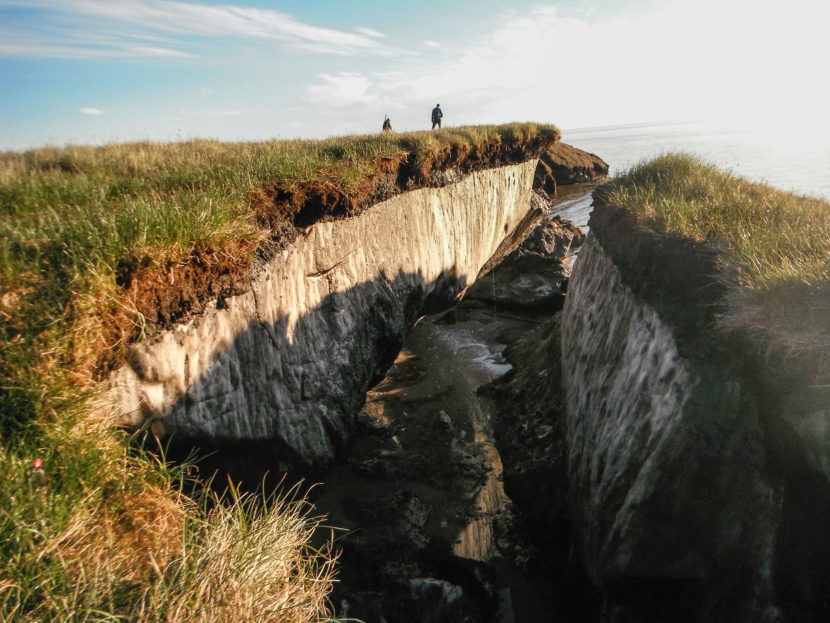
Russian officials say warming permafrost could be linked to a deadly anthrax outbreak in Siberia this month. Permafrost can be found almost everywhere in Alaska — from the Arctic coast to Anchorage. But at least one expert isn’t alarmed about the potential for thawing ground to bring old diseases back to life.
After a Siberian heat wave, anthrax hit the Yamal Peninsula in early August. The bacterial disease has claimed the life of a child and thousands of reindeer.
Permafrost expert Vladimir Romanovsky of the University of Alaska Fairbanks says melting permafrost and erosion may have worked together to spread anthrax into the water supply.
“Thawing of permafrost can release microorganisms first into the active layer, then into water and air,” said Romanovsky. “They were sequestered there for many, many years — tens of years, even thousands and tens of thousands of years.”
Romanovsky says scientists have talked about the possibility of epidemics caused by thawing permafrost, but until now, it’s only been a theory. If the Siberian anthrax outbreak is traced back to spores in the permafrost, it would be a troubling development.
“This release of these dangerous microorganisms could actually be spread very easily from the north, because we have lots of birds who are migrating all kind of places in the world,” he said. “So this problem could be not just local problem. It could be global problem.”
Romanovsky says more research is needed to tie this anthrax outbreak to warming permafrost.
Doctor David Morens is an infectious disease specialist with the National Institutes of Health. He’s not worried about anthrax — or any other disease — surfacing from the ground. He says anthrax is hardy and virtually everywhere.
“Anthrax is sitting in the grass in farms in Texas,” Morens said. “It’s in Asia. It’s in Africa. It’s everywhere. And so the fact that some might be in the permafrost doesn’t really add to whatever the risk is.”
Although anthrax is widespread, the chance of getting sick from it is really small. And the likelihood of contracting anthrax from spores exhumed from the permafrost? Even tinier.
Morens has studied the 1918 Spanish influenza pandemic that decimated rural villages in Alaska. Brevig Mission was hit especially hard. Spanish flu killed 90 percent of the village over the course of six days. The remains of victims were buried together.
Researchers have used samples from that mass grave to reconstruct the genetic code of the virus. But Morens says Alaskans shouldn’t be afraid of getting sick as the ground in Brevig Mission thaws. He says unlike anthrax, Spanish flu is very fragile.
“What came out of the so-called permafrost was just broken pieces of RNA,” Morens said. “Nucleic acid. There was nothing infectious. A ton of it swallowed would have been harmless.”
Freezing and thawing breaks up viruses like Spanish flu, killing them.
“So if we are talking about viruses and deadly things, I would say whatever might be there in the permafrost is not going to be contagious,” he said.
Morens doesn’t fear viruses or bacteria emerging from their cryogenic slumber. But he is concerned about the threat of new diseases.
“All these emerging viruses that are coming on — Zika, chikungunya, severe acute respiratory syndrome (SARS), and all that,” Morens said. “It’s not that they’re being created. It’s not that they’re being dug up from the permafrost. They’re already there. And we human beings do things that invite them to come in, infect us, and cause epidemics.”
Officials in Russia are trying to stop the anthrax outbreak from spreading further. They are incinerating all infected reindeer carcasses and have banned hunting in the region.
Zoe Sobel is a reporter with Alaska's Energy Desk based in Unalaska. As a high schooler in Portland, Maine, Zoë Sobel got her first taste of public radio at NPR’s easternmost station. From there, she moved to Boston where she studied at Wellesley College and worked at WBUR, covering sports for Only A Game and the trial of convicted Boston Marathon bomber Dzhokhar Tsarnaev.




